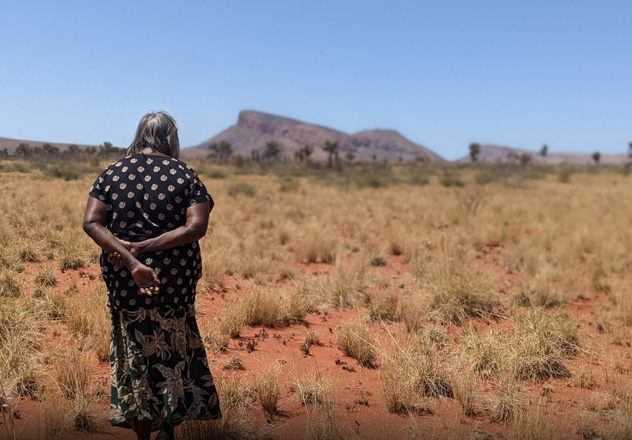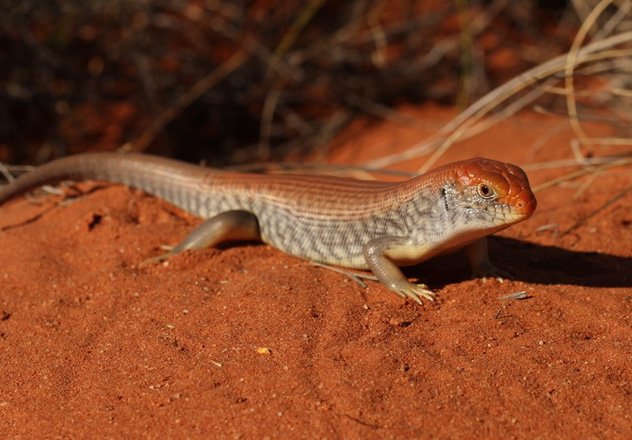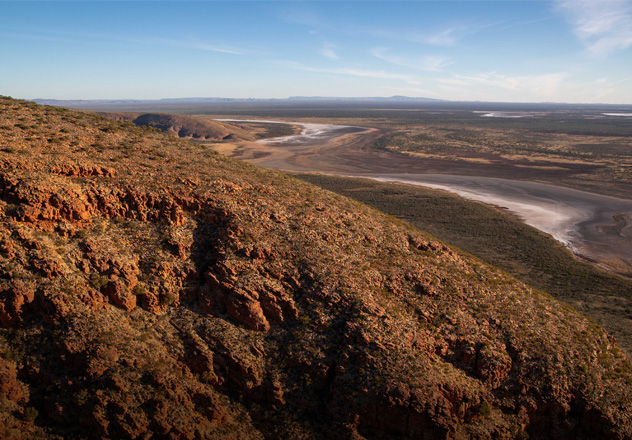By Dr Danae Moore, Wildlife Ecologist, Steve Eldridge, Operations manager, Naomi Lewis, Indigenous Ranger Coordinator, Shane McMasters, Land Management Officer
‘Working two-ways to protect country and culture’ – this is the statement that has been decided on by the custodians of the Ngalurrtju Aboriginal Land Trust, to represent the meaning of the partnership with Australian Wildlife Conservancy (AWC). The partnership has made good progress since it commenced in 2022.
A strong team of land management officers and ecologists has been established and is on the ground doing the hard work of setting up the operations base and conducting the first surveys and land management activities under the partnership. Regular planning meetings and community engagement is providing space for genuine two-way planning, learning and conservation.
The Ngalurrtju team is continuing to engage with the surrounding communities of Papunya and Laramba and there is a high level of interest from community members wanting to join the conservation land management work as rangers. At the first steering committee meeting in November 2022, Ngalurrtju Custodians and steering committee members were happy to see the results of AWC working hard to tidy up the old Mt Wedge Homestead. There were a lot of insightful contributions to the work plan for a busy year in 2023.
 Naomi Lewis/AWC
Naomi Lewis/AWC
Looking for Tjalapa
One of the initial priorities at Ngalurrtju is to confirm the presence of some of the threatened species predicted to occur there. In recent months, much of the attention has been on tracking down the Great Desert Skink (Liopholis kintorei), a large, nocturnal lizard. It is known by a number of different names in Aboriginal languages: on Ngalurrtju, Luritja/Pintupi speakers call them Tjalapa and on Newhaven the Warlpiri language name is Warrarna. It’s called Mulyamiji in the Manyjilijarra language spoken by Martu, and Tjakuṟa in many other desert languages.
In October 2022, the Ngalurrtju team and the Newhaven Rangers got together to share knowledge about Great Desert Skinks, to assist Ngalurrtju Custodians in finding any existing populations on Ngalurrtju. After learning about preferred habitat and how to identify Great Desert Skink warrens at Newhaven, the team searched similar habitat at Ngalurrtju. In this region, Great Desert Skinks are found in semi-saline spinifex sandplains, a vegetation community which covers 308 square kilometres on Ngalurrtju. The possibility of chancing on a Great Desert Skink warren could have been slim, but signs were soon identified after searching at three sites. In total, the team located six active warren systems, each with sign of male, female and juvenile individuals. Ngalurrtju Custodians were thrilled to know that this threatened species still persists on their Country.
In November 2022, members of the Ngalurrtju team and the Newhaven Ranger team attended the Indigenous Desert Alliance (IDA) Conference at Yulara, an annual event where First Nations ranger groups from across the desert get together to present their achievements, learn from others, share stories and connect with one another. More than 370 Indigenous Rangers took part in the 2022 conference. Ngalurrtju Wildlife Ecologist, Danae Moore, helped to run a workshop aimed at upskilling rangers in techniques to manage and monitor Great Desert Skinks.
 Joe Schofield/AWC
Joe Schofield/AWC
In March 2023, the Ngalurrtju team was involved in the first ever ‘Mulyamiji March’. Coordinated by IDA, this is a collaborative national monitoring event where 15 ranger teams across three states monitored around 50 separate sites for active Great Desert Skink burrow systems. It’s the start of a decade of planned annual monitoring across the species’ range, gathering valuable data which will be used to track national trends and inform recovery actions.
“Us Rangers, we know where Warrarna living. So we look between the salt lake and the sand dunes, we know where they are. Warrarna lives with its family in one burrow. Mum and dad look after them. Sometimes dad goes out looking for a feed and make another burrow then comes back and they make scat on one place. So there’s different scat you can find next to the burrow, there’s a big one, small one and the baby one.” – Christine Ellis, Newhaven Ranger, quoted in Draft National Recovery Plan for the Great Desert Skink 2022 – 2032
Great Desert Skinks are unusual among reptiles in showing dedicated parental care. They are highly social, living in extensive communal burrow systems which provide a safe, thermally stable refuge. The burrows are also used by other animals like the Brush-tailed Mulgara (Dasycercus blythi). The major threats to Great Desert Skinks are extensive fire that removes all groundcover and predation by feral cats and foxes. AWC teams at both Newhaven and Ngalurrtju will carry out targeted prescribed burning and predator control to protect known populations of Great Desert Skinks.
 Brad Leue/AWC
Brad Leue/AWC
Infrastructure upgrades
In early 2023, the Ngalurrtju team worked to prepare the former Mt Wedge homestead building for the installation of reliable electricity. The rewiring will enable the installation of new lights, power points, and (critically) air-conditioning, making it fit for purpose as an operations base for the surveys and land management work planned for this year. Extensive grading of the existing roads network has been carried out by long-time AWC employee and Ngalurrtju Custodian Duncan Jangala to re-open the network of tracks across Ngalurrtju, in preparation for prescribed burning operations getting underway in the cooler months.
Vegetation mapping & weed control
A ground survey was carried out over several days in spring of 2022, with rapid assessment of landform, soils, and dominant vegetation along roads and tracks across Ngalurrtju. Around 460 vascular plant taxa have been recorded on Ngalurrtju (a total that includes ten introduced plant species). Fortunately, the occurrence of weeds is minimal, apart from a significant expansion in buffel grass (Cenchrus ciliaris) since the 1980s, and outbreaks of hairy-flowered lovegrass (Eragrostis trichophora). With the exception of buffel grass, most weeds are confined to roads and tracks and old cattle yard sites. In December 2022, after the first summer rains the Ngalurrtju team launched a major assault on weeds around the operations base along the main access roads, which involved spraying and manually removing buffel grass and hairy-flowered lovegrass. A long-term strategic commitment will be required to stop these weeds from spreading any further across Ngalurrtju.
Fire follows rain
In the desert, wetter years are invariably followed by years where fire is more widespread in the landscape. Above-average rainfall has been recorded on Ngalurrtju for the past two years, with wet conditions continuing into 2023. Planning for prescribed burning at Ngalurrtju in 2023 includes extensive, strategic landscape-scale burning over winter to reduce the impact of large wildfires during the warmer months. Huge wildfires in the nearby Tjoritja/West-MacDonnell National Park in March 2023 burned through more than 100,000 hectares, underscoring the risk of wildfire after periods of above-average rainfall and the negative influence of buffel grass, which fuels hotter and more extensive fires. AWC and the team at Ngalurrtju are working together to deliver best-practice fire management, which combines traditional knowledge, with over a decade of effective fire management techniques refined at Newhaven.
Read and download the full issue of Wildlife Matters here.
Support Australian Wildlife Conservancy's science-led conservation work
Donate Now